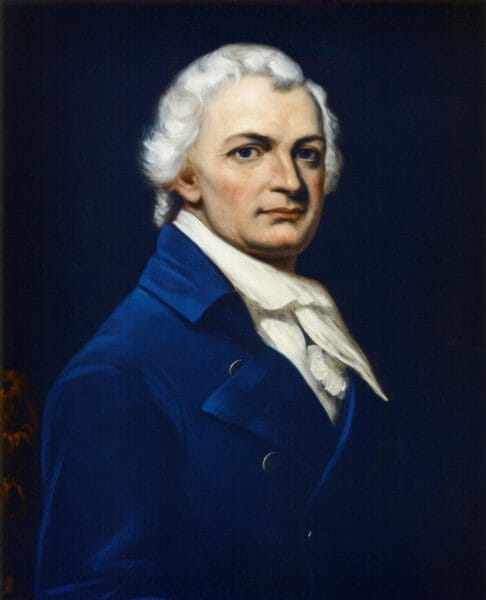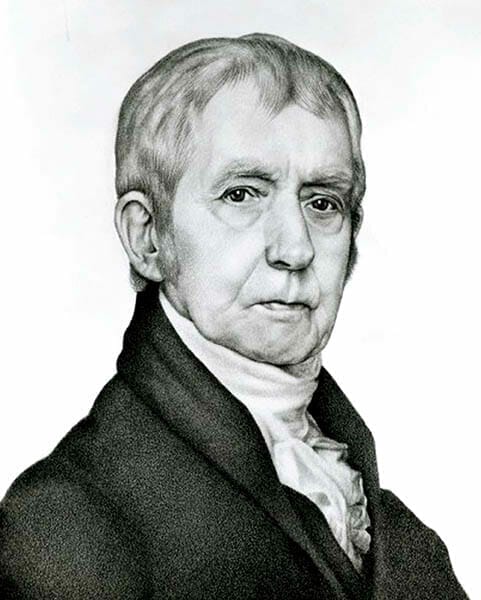Fort Stoddert
 Benjamin Stoddert
Fort Stoddert was a U.S. military installation established in 1799 some 30 miles north of Mobile on the Mobile River. After the U.S. Congress created the Mississippi Territory in 1798, the federal government sent out surveyors to determine the boundary between the United States and Spanish West Florida. Congress then sent the U.S Army to establish posts along that boundary to assert claim to the land. Fort Stoddert, sometimes spelled Stodderd, was the seat of federal authority in the region for 12 years or so, until the garrison was deployed at a military camp built at nearby Mount Vernon and the United States took possession of Mobile in 1813.
Benjamin Stoddert
Fort Stoddert was a U.S. military installation established in 1799 some 30 miles north of Mobile on the Mobile River. After the U.S. Congress created the Mississippi Territory in 1798, the federal government sent out surveyors to determine the boundary between the United States and Spanish West Florida. Congress then sent the U.S Army to establish posts along that boundary to assert claim to the land. Fort Stoddert, sometimes spelled Stodderd, was the seat of federal authority in the region for 12 years or so, until the garrison was deployed at a military camp built at nearby Mount Vernon and the United States took possession of Mobile in 1813.
A survey team led by Andrew Ellicott and Spanish appointee Stephen “Don Esteban” Minor defined the boundary separating the United States and Spanish West Florida at the 31st Parallel North. That mission was completed in April 1799. In July, Capt. Bartholomew Schaumburgh led the Second Infantry from Natchez, Mississippi Territory, to what would become present-day Alabama to build Fort Stoddert near present-day Mount Vernon, Mobile County. Lying some six miles north of the 31st Parallel and located near the confluence of the Tombigbee and Alabama Rivers, the fort would serve as the port of entry for trade goods and commodities and serve as a collection site for custom duties from those travelling by river to Mobile in Spanish West Florida. It also served as a post office and the Court of Admiralty that administered maritime justice for the Tombigbee District that was located on the west side of the Tombigbee River and included most Washington County, Mississippi Territory. The Mobile District, controlled by Spain, was bounded on the north by the 31st Parallel North, on the south by Gulf of Mexico, on the east by Perdido River, and on the west by Pearl River.
Schaumburgh’s men endured several months of sickness and low provisions but completed Fort Stoddert in August 1799. Named after the first U.S. Secretary of the Navy, Benjamin Stoddert, the fort was established at Ward’s Bluff on the Mobile River. The four-sided fort was a stockade construction, with blockhouses at each of its four corners. Fort Stoddert initially kept the peace between the United States and Spain by preventing American settlers in the Tombigbee District from engaging in conflicts with the Spanish in the Mobile District. Schambaugh remained in command of the post until Capt. Philip Schuyler was appointed in 1804.
 Harry Toulmin
As the seat of federal power in the region, Fort Stoddert was home to federal administrative officials, including Ephraim Kirby and Harry Toulmin. As commissioner of public lands and a U.S Superior Court judge, Kirby spent several months at Fort Stoddert following his 1804 appointment to the positions by Pres. Thomas Jefferson. During his time there, Kirby attempted to establish order within the Tombigbee and Tensaw Districts. Writing to Jefferson in May, Kirby complained of “savage” inhabitants and a “corrupt” administration of justice. In addition, Kirby described the settlement as desolate and impoverished, with improper buildings for a court, and implored Pres. Jefferson to relocate the seat of the courts to nearby St. Stephens, present-day Washington County. Post offices were established at Fort Stoddert and St. Stephens shortly after Kirby’s death from yellow fever in 1804; he was interred at Fort Stoddert. Jefferson had also offered Kirby the governorship of the Mississippi Territory before he knew Kirby had already died. Toulmin was appointed Mississippi Territorial judge by Jefferson in 1804. He was also stationed at the fort from 1805 until 1819 or so, when Alabama became a state and the legislature removed him as judge. During his tenure, he communicated with federal officials in Washington on various affairs, including the Creek War of 1813-14.
Harry Toulmin
As the seat of federal power in the region, Fort Stoddert was home to federal administrative officials, including Ephraim Kirby and Harry Toulmin. As commissioner of public lands and a U.S Superior Court judge, Kirby spent several months at Fort Stoddert following his 1804 appointment to the positions by Pres. Thomas Jefferson. During his time there, Kirby attempted to establish order within the Tombigbee and Tensaw Districts. Writing to Jefferson in May, Kirby complained of “savage” inhabitants and a “corrupt” administration of justice. In addition, Kirby described the settlement as desolate and impoverished, with improper buildings for a court, and implored Pres. Jefferson to relocate the seat of the courts to nearby St. Stephens, present-day Washington County. Post offices were established at Fort Stoddert and St. Stephens shortly after Kirby’s death from yellow fever in 1804; he was interred at Fort Stoddert. Jefferson had also offered Kirby the governorship of the Mississippi Territory before he knew Kirby had already died. Toulmin was appointed Mississippi Territorial judge by Jefferson in 1804. He was also stationed at the fort from 1805 until 1819 or so, when Alabama became a state and the legislature removed him as judge. During his tenure, he communicated with federal officials in Washington on various affairs, including the Creek War of 1813-14.
 Edmund P. Gaines
In 1807, Capt. Edmund Pendleton Gaines replaced Capt. Schuyler as commander of the fort and would serve there until 1811, at a time when the United States was considering suitable routes for what would become the Federal Road. From 1806 to 1811, when the road formally opened, Fort Stoddert served as a stop on the crucial postal route and military wagon road during its construction. In February 1807, Gaines arrested former vice president Aaron Burr near Fort Stoddert for treason and held him prisoner. That March, Gaines escorted Burr along the Federal Road to Washington, D.C to stand trial. Gaines’s younger brother, George Strother Gaines, the federally appointed cotton factor or federal trade agent at the Choctaw trading house in nearby St. Stephens, later related his impressions of the fort to historian Albert Pickett. Although Gaines described the barracks as suitable frame houses, he noted the lack of discipline amongst the troops, as well as the unfavorable health conditions during the summer owing to the fort’s location on the river, affirming Kirby’s complaints. During the summer months, Gaines recalled, troops were sent to a summer encampment at Mount Vernon to avoid illness.
Edmund P. Gaines
In 1807, Capt. Edmund Pendleton Gaines replaced Capt. Schuyler as commander of the fort and would serve there until 1811, at a time when the United States was considering suitable routes for what would become the Federal Road. From 1806 to 1811, when the road formally opened, Fort Stoddert served as a stop on the crucial postal route and military wagon road during its construction. In February 1807, Gaines arrested former vice president Aaron Burr near Fort Stoddert for treason and held him prisoner. That March, Gaines escorted Burr along the Federal Road to Washington, D.C to stand trial. Gaines’s younger brother, George Strother Gaines, the federally appointed cotton factor or federal trade agent at the Choctaw trading house in nearby St. Stephens, later related his impressions of the fort to historian Albert Pickett. Although Gaines described the barracks as suitable frame houses, he noted the lack of discipline amongst the troops, as well as the unfavorable health conditions during the summer owing to the fort’s location on the river, affirming Kirby’s complaints. During the summer months, Gaines recalled, troops were sent to a summer encampment at Mount Vernon to avoid illness.
In May 1811, John B. Hood of South Carolina and Samuel Miller of Tennessee brought a printing press down the Alabama River from Chattanooga to Fort Stoddert and began the first newspaper in what would become Alabama. The Mobile Centinel ran from May 23, 1811, to June 6, 1812. Readers could purchase subscriptions for $4 a year to keep up with news coming from Spanish West Florida during the War of 1812.
 St. Stephens District Map
During the War of 1812, Lt. Col. John Bowyer led troops from Fort Stoddert to seize Mobile from Spain in April 1813; Gen. James Wilkinson accepted the Spanish surrender. Claiming Mobile as a U.S. territory resolved a long-standing dispute over ownership of lands between the Mississippi and Perdido Rivers. Later that year, Fort Stoddert hosted refugees fleeing from nearby settlements after the destruction of and massacre at Fort Mims and at the outset of the Creek War. During that war, the fort served as the military headquarters for Gen. Ferdinand Claiborne’s Mississippi Territorial Volunteers.
St. Stephens District Map
During the War of 1812, Lt. Col. John Bowyer led troops from Fort Stoddert to seize Mobile from Spain in April 1813; Gen. James Wilkinson accepted the Spanish surrender. Claiming Mobile as a U.S. territory resolved a long-standing dispute over ownership of lands between the Mississippi and Perdido Rivers. Later that year, Fort Stoddert hosted refugees fleeing from nearby settlements after the destruction of and massacre at Fort Mims and at the outset of the Creek War. During that war, the fort served as the military headquarters for Gen. Ferdinand Claiborne’s Mississippi Territorial Volunteers.
Fort Stoddert rapidly declined in importance after Claiborne moved his headquarters to Mount Vernon and after the United States captured Mobile. By 1814, it no longer served as a military headquarters; a postmaster continued to be stationed there until 1830. Although Fort Stoddert ceased to function as a military outpost, the name remained associated with the surrounding community. Later, the town would become known as Mount Vernon for the arsenal constructed three miles west of Fort Stoddert. In 1817, the Alabama Territory was created out of the Mississippi Territory and Alabama became a state on December 14, 1819.
A marker and a series of interpretive panels commemorating Fort Stoddert and Ephraim Kirby’s gravesite can be found at the northeast intersection of the Old Military Road and U.S Highway 43.
Further Reading
- Bunn, Mike, and Susie Hartman. Fort Stoddert: American Sentinel on the Mobile River, 1799-1814. Bristol, UK: Intellect Books, 2023.



